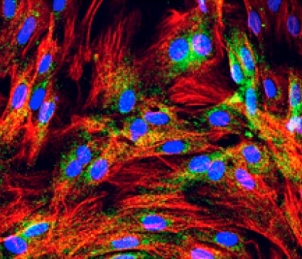
See that aberrant astrocyte (ABA). Scientists identified a new kind of astrocyte in rats called ABA which produces distinct substances including S100β (red) which may contribute to degeneration of motor neurons in the spinal cord. Adapted from Diaz-Amarilla et al. (2011). Courtesy of the National Academy of Sciences Press. All rights reserved.
People with ALS experience muscle weakness and ultimately paralysis due to the degeneration of their motor nerves. Recent studies suggest that neighboring cells called astrocytes could contribute to this deterioration. But why astrocytes turn traitor and kill motor neurons remains unclear.
Now, a new study in rats from Uruguay’s Institut Pasteur de Montevideo suggests instead that a new kind of astrocyte may arise during the onset of ALS and contribute to disease progression.
“There is a new element, a new actor,” says lead author and institute director Luis Barbeito MD, “that is killing motor neurons, triggering neuroinflammation.”
The study is published this month in Proceedings of the National Academy of Sciences.
Scientists isolated astrocytes from the cervical spinal cord of rats before symptoms or at the early or end-stage of the disease. The team found a distinct type of astrocyte that appeared at ALS onset and that produced substances previously implicated in neuronal injury and diseases including ALS.
“There is a perfect correlation between disease progression and the number of [ABA] cells that appear around motor neurons.” What’s more, says Barbeito, “these cells are proliferating. This is strong evidence that these cells are killing motor neurons.”
The researchers are now looking at post-mortem tissue samples obtained from people with ALS to determine whether or not these same astrocytes are associated with the human form of the disease.
Looking ahead, these astrocytes could be used to screen for new ALS drugs by screening for compounds that neutralize their toxicity. And, these astrocytes could be further characterized to identify unique cell surface markers that could be used to design antibody-based therapies directed toward these cells to eliminate them from the spinal cord.
References
Díaz-Amarilla, P., Olivera-Bravo, S., Trias, E., Cragnolini, A., Martínez-Palma, L., Cassina, P., Beckman, J., Barbeito, L. (2011) Phenotypically aberrant astrocytes that promote motoneuron damage in a model of inherited amyotrophic lateral sclerosis. Proceedings of the National Academy of Sciences. doi: 10.1073/pnas.1110689108 Abstract | Full Text (Subscription Required)
Migheli, A., Cordera, S., Bendotti, C., Atzori, C., Piva, R., and Schiffer, D. (2011) S-100beta protein is upregulated in astrocytes and motor neurons in the spinal cord of patients with amyotrophic lateral sclerosis. Neuroscience Letters, 261(1-2), 25-28. Abstract | Full Text (Subscription Required)
Further Reading
Yamanaka, K., Chun, S.J., Boillee, S., Fujimori-Tonou, N., Yamashita, H., Gutmann, D.H., Takahashi, R., Misawa, H., and Cleveland, D.W.. (2008). Astrocytes as determinants of disease progression in inherited amyotrophic lateral sclerosis. Nature Neuroscience, 11(3), 251-253. Abstract | Full Text
Papadeas, S.T., Kraig, S.E., O'Banion, C., Lepore, A.C. and Maragakis N.J. (2011). Astrocytes carrying the superoxide dismutase 1 (SOD1G93A) mutation induce wild-type motor neuron degeneration in vivo. Proceedings of the National Academy of Sciences, 108(43), 17803-17808. Abstract | Full Text (Subscription Required)
Researcher Resources
ABA cells can be requested for further study by contacting Luis Barbeito MD. Email